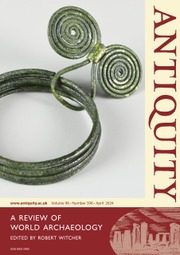
Most students enrolled in courses on ‘buried cities and ancient civilisations’ do not learn about Southeast Asia’s past, and those who do learn anything about the region will learn little about the eleventh- to early-nineteenth-century Thăng Long city that lies beneath Vietnam’s current capital city of Hanoi—this situation included, until rather recently, Vietnamese students. Yet, recent archaeological research on the Thăng Long capital offers new insights on Vietnam’s emergence from a millennium of Chinese domination and an excellent case study in urban archaeological practice. Andrew Hardy’s and Nguyễn Tiến Đông’s edited volume contributes an original archaeological case study of Đại Việt civilisation that offers both substantive and reflective comments on the materiality of a nation’s past.
This book is not a site report, but instead a summary of the work undertaken there and reflections on its meanings. Hardy’s introduction to the volume contextualises the book through a personal history of the excavations, the site’s UNESCO World Heritage nomination and an outline of the book. The following 12 chapters are divided into an archaeological section (Part I) and a historical section (Part II). Excavators summarise general findings from field projects on different sections of the ancient city in Chapters 1–6, and concentrate on salvage excavations undertaken between 2002 and 2004, during which hundreds of workers exposed an area of 19 000m2 and the work garnered daily mass-media attention. Some of the excavations remained exposed to the public until their 2010 inscription as a World Heritage site, and work continues today on other sections of the ancient city. Chapters 1–5 in Section I resonate most deeply with those of us who are archaeologically inclined.
Tống Trung Tín’s discussion of non-local finds indicates the capital’s cosmopolitan identity, with evidence of relationships with East Asia and the Middle East. Lê Thị Liên’s Chapter 2 offers an intimate view of life on the project, and Nguyễn Hồng Kiên’s architectural discussion of the excavations in Chapter 3 sheds light on the monumental scale of this medieval and Early Modern city. Chapters 4 and 5 (authored by Nguyễn Văn Anh & Đỗ Danh Huấn) provide the most fine-grained archaeological descriptions of this work, concentrating on site stratigraphy (Chapter 4) and building materials (Chapter 5). The section’s final chapter, authored by then director Nguyễn Văn Sơn, summarises how this site qualified for World Heritage status.
Yet, it is Section II that distinguishes this volume from most historical archaeological literature in East and Southeast Asia, because chapter authors probe the role of Thăng Long in historical memory and seek points of intersection between archaeological and documentary sources. Đào Hùng (Chapter 7) explains how this long-lived ancient capital holds a revered place in collective memory of local populations based on historical sources rather than on physical remains. Franciscus Verellen’s Chapter 8 then provides a detailed background to the ninth-century architecture of Hanoi’s medieval citadel, which became the object of local cults during and beyond his lifetime. In Chapter 9, Phan Huy Lê brings maps and documentary sources to bear on descriptions of the structure of the capital’s Imperial Citadel through time. Chapter 10, in which Nguyễn Tiến Đông examines Vietnamese and Champa interaction, might better have been placed in Section I. Still, it is one of the volume’s most intriguing chapters, both for its personal approach and for its focus on how Champa culture (experienced largely through captured Cham elites who were brought to the capital) exerted influences on Đại Việt material and intangible cultures. Such evidence demands revisions of the conventional narrative, in which Đại Việt civilisation inexorably destroyed Champa culture in its march southward, and suggests more syncretism than historians previously imagined. Phạm Văn Triệu’s comparison of historical maps and documentary sources with new archaeological data in Chapter 11 identifies points of convergence and divergence, underscoring methodological challenges of interdisciplinary research. The book concludes with Olivier Tessler’s history of Thăng Long’s nineteenth-century destruction under the Nguyễn dynasty, largely between 1802 and 1848. Historians might debate Tessler’s contention that Nguyễn rulers’ construction efforts in Hanoi that eradicated most vestiges of Thăng Long were designed to strip the former capital of its power (see p.254), but the imperial capital’s shift to Hue signalled the end of Thăng Long’s dominance. By the time of the French capture of Hanoi in 1883, however, few physical remains existed from the former royal capital.
This edited volume holds great value to archaeologists and historians who study Southeast Asia and offers more than simply reporting on one of the region’s longest-lived cities. Scholars working globally who seek local perspectives on national history (which often elude readers unless they are fluent in the national language) might also find value in this Western-language work by largely Vietnamese authors. That Thăng Long is now a World Heritage site makes this volume even more important because it provides the context and substantial scholarly rationale for its designation. Hardy and Nguyễn have created a robust scholarly publication.
Yet, beyond all these academic contributions lies a uniquely personal perspective that gives this edited volume a special appeal. Đào Hùng’s whimsical exclamation on excavated bricks—whose emergence from silent sleep into the sunlight brings severe sun and heat, leads him to write, “Pity the poor bricks” (p.110)—surprises and delights the reader. So does Lê Thị Liên’s candid view of the world of excavation in Chapter 2, where the joys of discovery are counterposed against challenges of hitting the water table during architectural excavations (pp.76–77). Hard end-dates that archaeologists face in salvage archaeology excavations bring constant frustration and stress to the Thăng Long teams—such glimpses evoke empathy from archaeologist readers. The authors also welcome us into an archaeological world whose practitioners and their work seem remarkably familiar, despite distances in geography and subject, and remind us why we love our field.

